light CITROEN E-MEHARI 2023 User Guide
[x] Cancel search | Manufacturer: CITROEN, Model Year: 2023, Model line: E-MEHARI, Model: CITROEN E-MEHARI 2023Pages: 84, PDF Size: 3.48 MB
Page 55 of 84
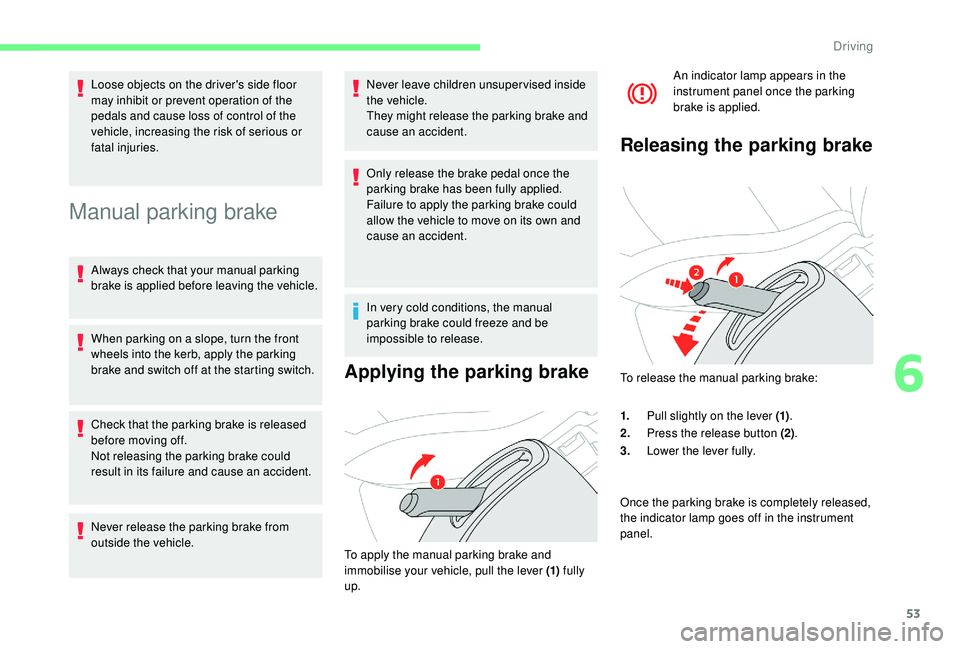
53
Manual parking brake
Always check that your manual parking
brake is applied before leaving the vehicle.
When parking on a slope, turn the front
wheels into the kerb, apply the parking
brake and switch off at the starting switch.
Check that the parking brake is released
before moving off.
Not releasing the parking brake could
result in its failure and cause an accident.
Never release the parking brake from
outside the vehicle. Never leave children unsuper vised inside
the vehicle.
They might release the parking brake and
cause an accident.
Only release the brake pedal once the
parking brake has been fully applied.
Failure to apply the parking brake could
allow the vehicle to move on its own and
cause an accident.
In very cold conditions, the manual
parking brake could freeze and be
impossible to release.
Applying the parking brake
To apply the manual parking brake and
immobilise your vehicle, pull the lever (1)
fully
up. An indicator lamp appears in the
instrument panel once the parking
brake is applied.
Releasing the parking brake
Loose objects on the driver's side floor
may inhibit or prevent operation of the
pedals and cause loss of control of the
vehicle, increasing the risk of serious or
fatal injuries.
To release the manual parking brake:
1.Pull slightly on the lever (1) .
2. Press the release button (2) .
3. Lower the lever fully.
Once the parking brake is completely released,
the indicator lamp goes off in the instrument
panel.
6
Driving
Page 59 of 84
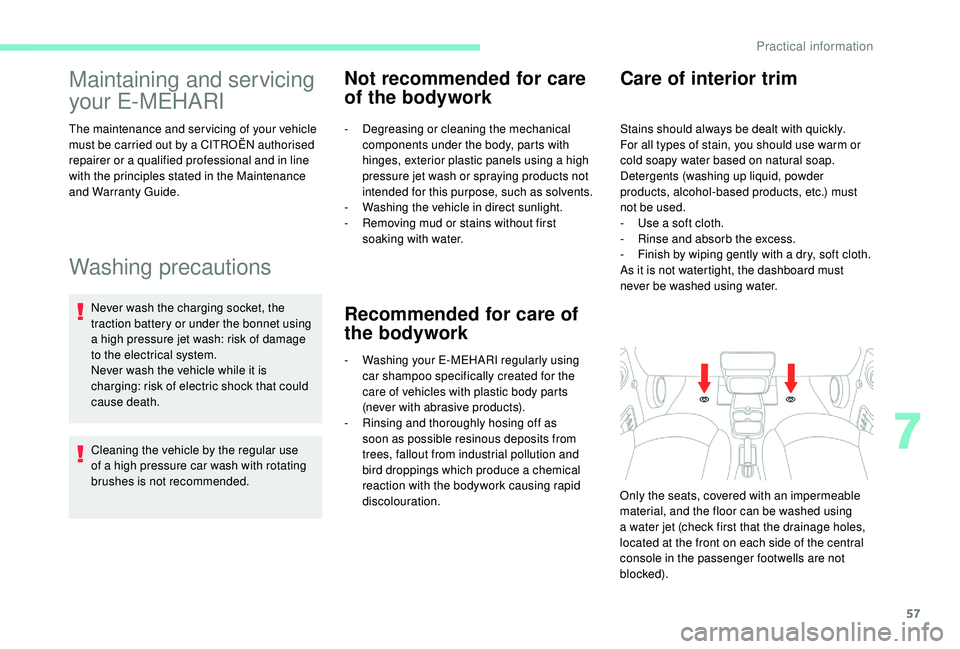
57
Maintaining and servicing
your E-MEHARI
The maintenance and servicing of your vehicle
must be carried out by a CITROËN authorised
repairer or a
qualified professional and in line
with the principles stated in the Maintenance
and Warranty Guide.
Washing precautions
Never wash the charging socket, the
traction battery or under the bonnet using
a
high pressure jet wash: risk of damage
to the electrical system.
Never wash the vehicle while it is
charging: risk of electric shock that could
cause death.
Cleaning the vehicle by the regular use
of a
high pressure car wash with rotating
brushes is not recommended.
Not recommended for care
of the bodywork
- Degreasing or cleaning the mechanical components under the body, parts with
hinges, exterior plastic panels using a
high
pressure jet wash or spraying products not
intended for this purpose, such as solvents.
-
W
ashing the vehicle in direct sunlight.
-
R
emoving mud or stains without first
soaking with water.
Recommended for care of
the bodywork
- Washing your E-MEHARI regularly using car shampoo specifically created for the
care of vehicles with plastic body parts
(never with abrasive products).
-
R
insing and thoroughly hosing off as
soon as possible resinous deposits from
trees, fallout from industrial pollution and
bird droppings which produce a
chemical
reaction with the bodywork causing rapid
discolouration. Only the seats, covered with an impermeable
material, and the floor can be washed using
a
water jet (check first that the drainage holes,
located at the front on each side of the central
console in the passenger footwells are not
blocked).
Care of interior trim
Stains should always be dealt with quickly.
For all types of stain, you should use warm or
cold soapy water based on natural soap.
Detergents (washing up liquid, powder
products, alcohol-based products, etc.) must
not be used.
-
U
se a soft cloth.
-
R
inse and absorb the excess.
-
F
inish by wiping gently with a dry, soft cloth.
As it is not watertight, the dashboard must
never be washed using water.
7
Practical information
Page 62 of 84
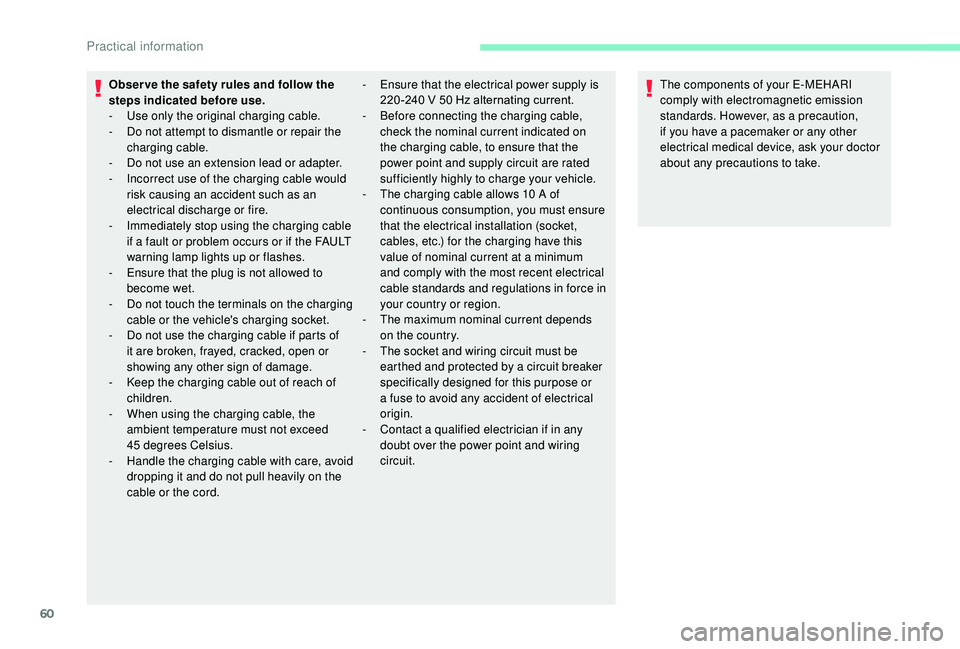
60
Obser ve the safety rules and follow the
steps indicated before use.
-
Us
e only the original charging cable.
-
D
o not attempt to dismantle or repair the
charging cable.
-
D
o not use an extension lead or adapter.
-
I
ncorrect use of the charging cable would
risk causing an accident such as an
electrical discharge or fire.
-
I
mmediately stop using the charging cable
if a
fault or problem occurs or if the FAULT
warning lamp lights up or flashes.
-
E
nsure that the plug is not allowed to
become wet.
-
D
o not touch the terminals on the charging
cable or the vehicle's charging socket.
-
D
o not use the charging cable if parts of
it are broken, frayed, cracked, open or
showing any other sign of damage.
-
K
eep the charging cable out of reach of
children.
-
W
hen using the charging cable, the
ambient temperature must not exceed
45
degrees Celsius.
-
H
andle the charging cable with care, avoid
dropping it and do not pull heavily on the
cable or the cord. The components of your E-MEHARI
comply with electromagnetic emission
standards. However, as a
precaution,
if you have a
pacemaker or any other
electrical medical device, ask your doctor
about any precautions to take.
-
E nsure that the electrical power supply is
220 -240 V 50 Hz alternating current.
-
B
efore connecting the charging cable,
check the nominal current indicated on
the charging cable, to ensure that the
power point and supply circuit are rated
sufficiently highly to charge your vehicle.
-
T
he charging cable allows 10 A of
continuous consumption, you must ensure
that the electrical installation (socket,
cables, etc.) for the charging have this
value of nominal current at a
minimum
and comply with the most recent electrical
cable standards and regulations in force in
your country or region.
-
T
he maximum nominal current depends
on the country.
-
T
he socket and wiring circuit must be
earthed and protected by a
circuit breaker
specifically designed for this purpose or
a
fuse to avoid any accident of electrical
origin.
-
C
ontact a qualified electrician if in any
doubt over the power point and wiring
circuit.
Practical information
Page 63 of 84
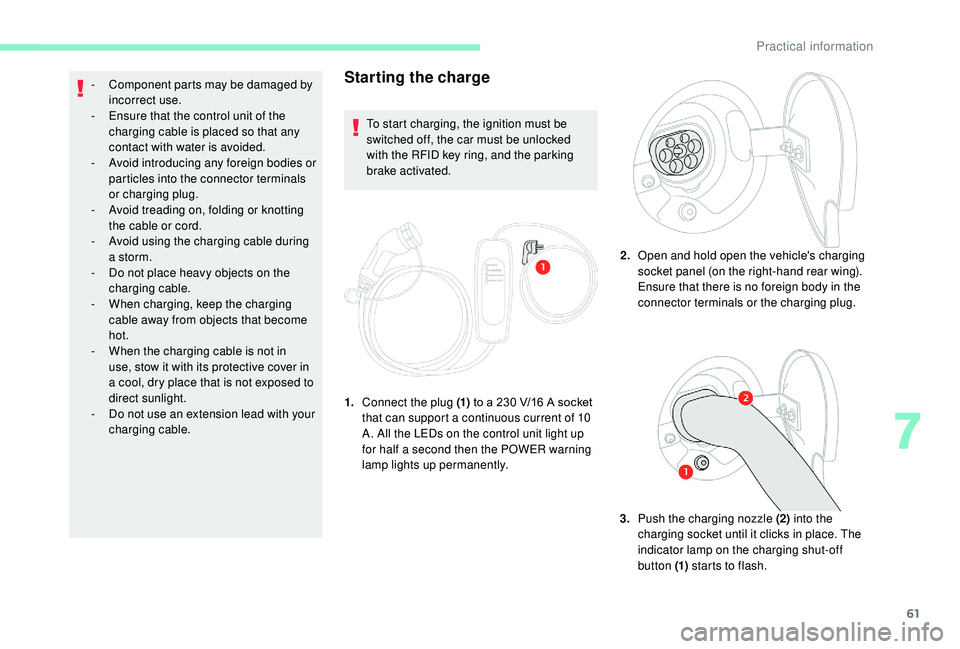
61
Starting the charge
To start charging, the ignition must be
switched off, the car must be unlocked
with the RFID key ring, and the parking
brake activated.
1. Connect the plug (1) to a
230 V/16 A socket
that can support a
continuous current of 10
A. All the LEDs on the control unit light up
for half a
second then the POWER warning
lamp lights up permanently. 2.
Open and hold open the vehicle's charging
socket panel (on the right-hand rear wing).
Ensure that there is no foreign body in the
connector terminals or the charging plug.
3. Push the charging nozzle (2) into the
charging socket until it clicks in place. The
indicator lamp on the charging shut-off
button (1) starts to flash.
-
C
omponent parts may be damaged by
incorrect use.
-
E
nsure that the control unit of the
charging cable is placed so that any
contact with water is avoided.
-
A
void introducing any foreign bodies or
particles into the connector terminals
or charging plug.
-
A
void treading on, folding or knotting
the cable or cord.
-
A
void using the charging cable during
a
storm.
-
D
o not place heavy objects on the
charging cable.
-
W
hen charging, keep the charging
cable away from objects that become
hot.
-
W
hen the charging cable is not in
use, stow it with its protective cover in
a
cool, dry place that is not exposed to
direct sunlight.
-
D
o not use an extension lead with your
charging cable.
7
Practical information
Page 65 of 84
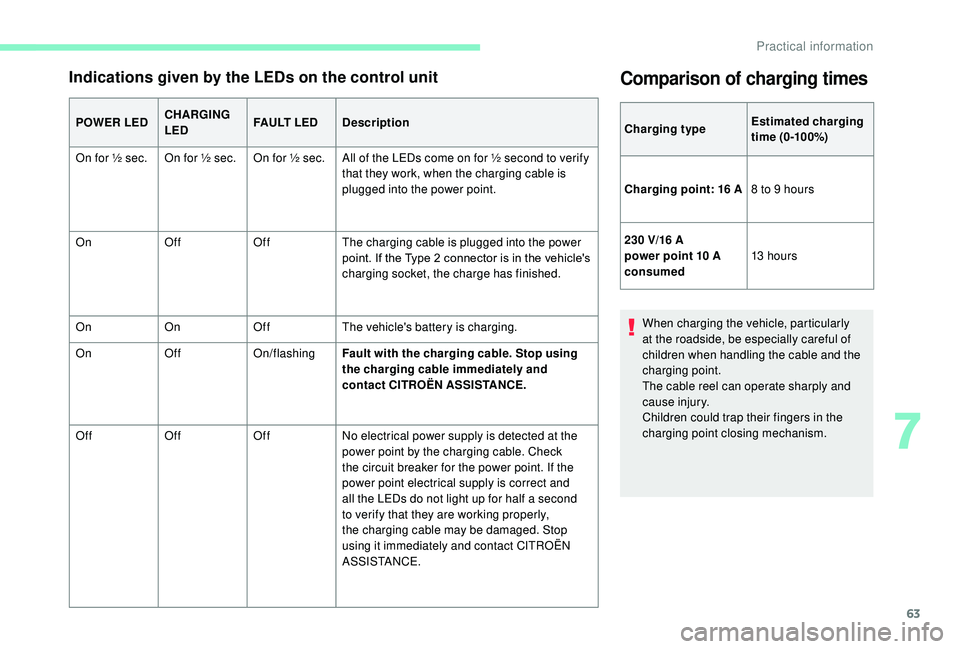
63
Indications given by the LEDs on the control unit
POWER LEDCHARGING
LEDFA U LT L E D
Description
On for ½ sec. On for ½ sec. On for ½ sec. All of the LEDs come on for ½ second to verify that they work, when the charging cable is
plugged into the power point.
On OffOffThe charging cable is plugged into the power
point. If the Type 2
connector is in the vehicle's
charging socket, the charge has finished.
On OnOffThe vehicle's battery is charging.
On OffOn/flashingFault with the charging cable. Stop using
the charging cable immediately and
contact CITROËN ASSISTANCE.
Off OffOffNo electrical power supply is detected at the
power point by the charging cable. Check
the circuit breaker for the power point. If the
power point electrical supply is correct and
all the LEDs do not light up for half a
second
to verify that they are working properly,
the charging cable may be damaged. Stop
using it immediately and contact CITROËN
ASSISTANCE.
Comparison of charging times
Charging type Estimated charging
time (0-100%)
Charging point: 16
A8
to 9 hours
230 V/16 A
power point 10 A
consumed 13 hour s
When charging the vehicle, particularly
at the roadside, be especially careful of
children when handling the cable and the
charging point.
The cable reel can operate sharply and
cause injury.
Children could trap their fingers in the
charging point closing mechanism.
7
Practical information
Page 79 of 84
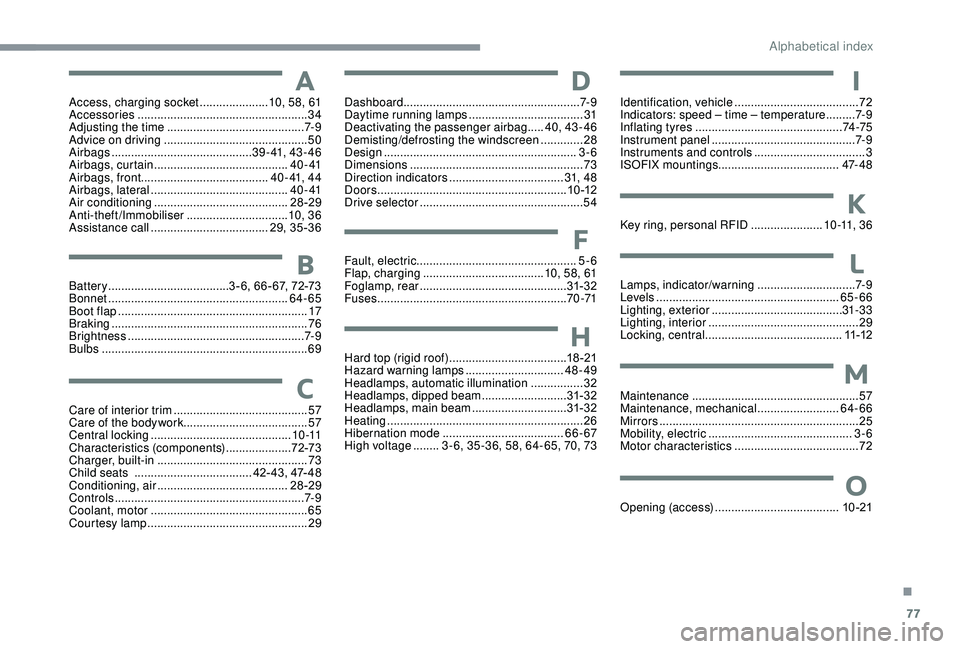
77
Access, charging socket .....................10, 58, 61
Accessories .................................................... 34
Adjusting the time
.......................................... 7- 9
Advice on driving
............................................ 50
Airbags
...............................
............39-41, 43-46
Airbags, curtain
......................................... 4 0 - 41
Airbags, front ....................................... 4 0 - 41, 4 4
Airbags, lateral
.......................................... 4 0 - 41
Air conditioning
......................................... 28-29
Anti-theft/Immobiliser
...............................10, 36
Assistance call
...............................
.....29, 35 -36
Care of interior trim
......................................... 57
C
are of the bodywork...................................... 57
Central locking
........................................... 1
0 -11
Characteristics (components)
....................72-73
Charger, built-in
.............................................. 73
Child seats
..............................
......42- 43, 47- 48
Conditioning, air
........................................ 28-29
Controls
.......................................................... 7- 9
Coolant, motor
................................................ 65
Courtesy lamp
................................................. 29A
B
C
Battery ..................................... 3 - 6, 66 - 67, 72-73
Bonnet ....................................................... 64-65
Boot flap
.......................................................... 17
Braking
...............
............................................. 76
Brightness
...................................................... 7- 9
Bulbs
............................................................... 69
F
H
I
Fault, electric .................................................5-6
Flap, charging ..................................... 1
0, 58, 61
Foglamp, rear
............................................. 31- 32
Fuses
.......................................................... 7
0 -71
Hard top (rigid roof)
.................................... 18
-21
Hazard warning lamps
..............................48-49
Headlamps, automatic illumination
................32
Headlamps, dipped beam
..........................31- 32
Headlamps, main beam
.............................31- 32
Heating
............................................................ 26
Hi
bernation mode
..................................... 66 - 67
High voltage
........3 - 6, 35 -36, 58, 64- 65, 70, 73 Identification, vehicle
......................................
72
Indicators: speed – time – temperature .........
7- 9
Inflating tyres
.............................................
74 -75
Instrument panel
............................................
7- 9
Instruments and controls ..................................
3
ISOFIX mountings ..................................... 47- 4 8
D
Dashboard ...................................................... 7- 9
Daytime running lamps ...................................31
Deactivating the passenger airbag
.....40, 43 - 46
Demisting/defrosting the windscreen
.............28
Design
........................................................... 3-6
Dimensions
..............................
.......................73
Direction indicators
................................... 31, 4 8
Doors
.......................................................... 10 -12
Drive selector
.................................................. 54K
Key ring, personal RFID ......................1 0 -11, 3 6
Lamps, indicator/warning
.............................. 7-
9
Levels
........................................................ 65-66
Lighting, exterior
........................................ 31- 33
Lighting, interior
...............................
...............29
Locking, central
...............................
...........11 -12
L
M
Maintenance ................................................... 57
Maintenance, mechanical .........................64-66
Mirrors
...............................
..............................25
Mobility, electric
............................................ 3-6
Motor characteristics
...................................... 72
O
Opening (access) ...................................... 10 -21
.
Alphabetical index